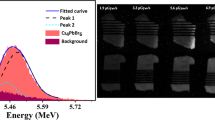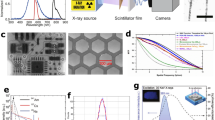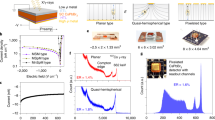Abstract
Radiation detection is of utmost importance in fundamental scientific research, as well as medical diagnostics, homeland security, environmental monitoring and industrial control. Lead halide perovskites (LHPs) are attracting growing attention as high-atomic-number materials for next-generation scintillators and photoconductors for ionizing radiation detection. To unlock their full potential as reliable and cost-effective alternatives to conventional materials, it is necessary for LHPs to conjugate high scintillation yields with emission stability under high doses of ionizing radiation. To date, no definitive solution has been devised to optimize the scintillation efficiency and kinetics of LHPs and nothing is known of their radiation hardness for doses above a few kilograys, to the best of our knowledge. Here we demonstrate that CsPbBr3 nanocrystals exhibit exceptional radiation hardness for γ-radiation doses as high as 1 MGy. Spectroscopic and radiometric experiments highlight that despite their defect tolerance, standard CsPbBr3 nanocrystals suffer from electron trapping in dense surface defects that are eliminated by post-synthesis fluorination. This results in >500% enhancement in scintillation efficiency, which becomes comparable to commercial scintillators, and still retaining exceptional levels of radiation hardness. These results have important implications for the widespread use of LHPs in ultrastable and efficient radiation detectors.
This is a preview of subscription content, access via your institution
Access options
Access Nature and 54 other Nature Portfolio journals
Get Nature+, our best-value online-access subscription
$29.99 / 30 days
cancel any time
Subscribe to this journal
Receive 12 print issues and online access
$209.00 per year
only $17.42 per issue
Buy this article
- Purchase on Springer Link
- Instant access to full article PDF
Prices may be subject to local taxes which are calculated during checkout




Similar content being viewed by others
Data availability
The data that support the findings of this study are available from the corresponding authors upon reasonable request.
References
Dujardin, C. et al. Needs, trends, and advances in inorganic scintillators. IEEE Trans. Nucl. Sci. 65, 1977–1997 (2018).
Kim, C. et al. A review of inorganic scintillation crystals for extreme environments. Crystals 11, 669 (2021).
Knoll, G. F. Radiation Detection and Measurement (John Wiley & Sons, 2010).
Xu, Q. et al. Bulk organic-inorganic methylammonium lead halide perovskite single crystals for indirect gamma ray detection. ACS Appl. Mater. Interfaces 11, 47485–47490 (2019).
Chen, W. et al. X-ray radioluminescence effect of all-inorganic halide perovskite CsPbBr3 quantum dots. J. Radioanal. Nucl. Chem. 314, 2327–2337 (2017).
Gandini, M. et al. Efficient, fast and reabsorption-free perovskite nanocrystal-based sensitized plastic scintillators. Nat. Nanotechnol. 15, 462–468 (2020).
Yu, D. et al. Two-dimensional halide perovskite as β-ray scintillator for nuclear radiation monitoring. Nat. Commun. 11, 3395 (2020).
Rodà, C. et al. Understanding thermal and a‐thermal trapping processes in lead halide perovskites towards effective radiation detection schemes. Adv. Funct. Mater. 31, 2104879 (2021).
Xu, Z. et al. CsPbBr3 quantum dot films with high luminescence efficiency and irradiation stability for radioluminescent nuclear battery application. ACS Appl. Mater. Interfaces 11, 14191–14199 (2019).
Liu, X. Y., Pilania, G., Talapatra, A. A., Stanek, C. R. & Uberuaga, B. P. Band-edge engineering to eliminate radiation-induced defect states in perovskite scintillators. ACS Appl. Mater. Interfaces 12, 46296–46305 (2020).
Stroyuk, O. et al. Origin and dynamics of highly efficient broadband photoluminescence of aqueous glutathione-capped size-selected Ag–In–S quantum dots. J. Phys. Chem. C 122, 13648–13658 (2018).
Birowosuto, M. et al. X-ray scintillation in lead halide perovskite crystals. Sci. Rep. 6, 37254 (2016).
Berger, M. J. et al. XCOM: Photon Cross Section Database (Version 1.5) (National Institute of Standards and Technology, 2010).
Stroyuk, O. et al. Inherently broadband photoluminescence in Ag–In–S/ZnS quantum dots observed in ensemble and single-particle studies. J. Phys. Chem. C 123, 2632–2641 (2019).
Chen, Q. et al. All-inorganic perovskite nanocrystal scintillators. Nature 561, 88–93 (2018).
Wei, W. et al. Monolithic integration of hybrid perovskite single crystals with heterogenous substrate for highly sensitive X-ray imaging. Nat. Photon. 11, 315–321 (2017).
Wei, H. & Huang, J. Halide lead perovskites for ionizing radiation detection. Nat. Commun. 10, 1066 (2019).
Protesescu, L. et al. Nanocrystals of cesium lead halide perovskites (CsPbX3, X = Cl, Br, and I): novel optoelectronic materials showing bright emission with wide color gamut. Nano Lett. 15, 3692–3696 (2015).
Imran, M. et al. Colloidal synthesis of strongly fluorescent CsPbBr3 nanowires with width tunable down to the quantum confinement regime. Chem. Mat. 28, 6450–6454 (2016).
Shamsi, J. et al. Bright-emitting perovskite films by large-scale synthesis and photoinduced solid-state transformation of CsPbBr3 nanoplatelets. ACS Nano 11, 10206–10213 (2017).
Nedelcu, G. et al. Fast anion-exchange in highly luminescent nanocrystals of cesium lead halide perovskites (CsPbX3, X = Cl, Br, I). Nano Lett. 15, 5635–5640 (2015).
Liu, J. et al. Flexible, printable soft-X-ray detectors based on all-inorganic perovskite quantum dots. Adv. Mater. 31, e1901644 (2019).
Vedda, A. et al. Trap-center recombination processes by rare earth activators in YAlO3 single crystal host. Phys. Rev. B 80, 045113 (2009).
Nikl, M., Laguta, V. V. & Vedda, A. Complex oxide scintillators: material defects and scintillation performance. Phys. Stat. Sol. B 245, 1701–1722 (2008).
Nikl, M. & Yoshikawa, A. Recent R&D trends in inorganic single-crystal scintillator materials for radiation detection. Adv. Opt. Mat. 3, 463–481 (2015).
Kitaura, M., et al. Shallow electron traps formed by Gd2+ ions adjacent to oxygen vacancies in cerium-doped Gd3Al2Ga3O12 crystals. Appl. Phys. Lett. 113, 041906 (2018).
Babin, V. et al. Effect of Mg2+ ions co-doping on luminescence and defects formation processes in Gd3(Ga,Al)5O12:Ce single crystals. Opt. Mater. 66, 48–58 (2017).
Ito, M., Hong, S. J. & Lee, J. S. Positron emission tomography (PET) detectors with depth-of- interaction (DOI) capability. Biomed. Eng. Lett. 1, 70–81 (2011).
Lecoq, P. Pushing the limits in time-of-flight PET imaging. IEEE Trans. Radiat. Plasma Med. Sci. 1, 473–485 (2017).
Yang, F., Zhang, L. Y. & Zhu, R. Y. Performances of crystal scintillators in a severe radiation environment caused by gamma rays. J. Phys. Conf. Ser. 928, 012032 (2017).
Olszacki, M. et al. Measurement of the high gamma radiation dose using the MEMS based dosimeter and radiolisys effect. in MicroMechanics Europe Workshop 31–35 (2013).
Todesco, E. et al. The high luminosity LHC interaction region magnets towards series production. Supercond. Sci. Technol. 34, 053001 (2021).
Forde, A. & Kilin, D. Defect tolerance mechanism revealed! Influence of polaron occupied surface trap states on CsPbBr3 nanocrystal photoluminescence: ab initio excited-state dynamics. J. Chem. Theory Comput. 17, 7224–7236 (2021).
Mykhaylyk, V. B. et al. Bright and fast scintillations of an inorganic halide perovskite CsPbBr3 crystal at cryogenic temperatures. Sci. Rep. 10, 8601 (2020).
Birowosuto, M. D. et al. X-ray scintillation in lead halide perovskite crystals. Sci. Rep. 6, 37254 (2016).
Liu, M. et al. Suppression of temperature quenching in perovskite nanocrystals for efficient and thermally stable light-emitting diodes. Nat. Photon. 15, 379–385 (2021).
Holl, I., Lorenz, E. & Mageras, G. A measurement of the light yield of common inorganic scintillators. IEEE Trans. Nucl. Sci. 35, 105–109 (1988).
Kapusta, M., Pawelke, J. & Moszyński, M. Comparison of YAP and BGO for high-resolution PET detectors. Nucl. Instrum. Methods Phys. Res. A: Accel. Spectrom. Detect. Assoc. Equip. 404, 413–417 (1998).
Moszynski, M., Kapusta, M., Mayhugh, M., Wolski, D. & Flyckt, S. O. Absolute light output of scintillators. IEEE Trans. Nucl. Sci. 44, 1052–1061 (1997).
van Eijk, C. W. E. Inorganic-scintillator development. Nucl. Instrum. Methods Phys. Res. A: Accel. Spectrom. Detect. Assoc. Equip. 460, 1–14 (2001).
Pokorný, M. et al. Gd-admixed (Lu,Gd)AlO3 single crystals: breakthrough in heavy perovskite scintillators. npg Asia Mater. 13, 66 (2021).
Cao, F. et al. Shining emitter in a stable host: design of halide perovskite scintillators for X-ray imaging from commercial concept. ACS Nano 14, 5183–5193 (2020).
Yang, H. et al. A novel scintillation screen for achieving high-energy ray detection with fast and full-color emission. J. Mater. Chem. C 9, 7905–7909 (2021).
Xu, Y., Zhao, X., Xia, M. & Zhang, X. Perovskite nanocrystal doped all-inorganic glass for X-ray scintillators. J. Mater. Chem. C 9, 5452–5459 (2021).
Cho, S. et al. Hybridisation of perovskite nanocrystals with organic molecules for highly efficient liquid scintillators. Light Sci. Appl. 9, 156 (2020).
Li, Z. et al. Aqueous synthesis of lead halide perovskite nanocrystals with high water stability and bright photoluminescence. ACS Appl. Mater. Interfaces 10, 43915–43922 (2018).
Wei, J.-H., Wang, X.-D., Liao, J.-F. & Kuang, D.-B. High photoluminescence quantum yield (>95%) of MAPbBr3 nanocrystals via reprecipitation from methylamine-MAPbBr3 liquid. ACS Appl. Electron. Mater. 2, 2707–2715 (2020).
Yang, L. et al. High-stable X-ray imaging from all-inorganic perovskite nanocrystals under a high dose radiation. J. Phys. Chem. Lett. 11, 9203–9209 (2020).
Xu, Q. et al. Effect of methylammonium lead tribromide perovskite based-photoconductor under gamma photons radiation. Radiat. Phys. Chem. 181, 109337 (2021).
Boldyreva, A. G. et al. Unravelling the material composition effects on the gamma ray stability of lead halide perovskite solar cells: MAPbI3 breaks the records. J. Phys. Chem. Lett. 11, 2630–2636 (2020).
Xu, Q. et al. A solution-processed zero-dimensional all-inorganic perovskite scintillator for high resolution gamma-ray spectroscopy detection. Nanoscale 12, 9727–9732 (2020).
Xu, Q. et al. Lead halide perovskite quantum dots based liquid scintillator for X-ray detection. Nanotechnology 32, 205201 (2021).
Mannino, G. et al. Temperature-dependent optical band gap in CsPbBr3, MAPbBr3, and FAPbBr3 single crystals. J. Phys. Chem. Lett. 11, 2490–2496 (2020).
Butkus, J. et al. The evolution of quantum confinement in CsPbBr3 perovskite nanocrystals. Chem. Mat. 29, 3644–3652 (2017).
Auffray, E. et al. Irradiation effects on Gd3Al2Ga3O12 scintillators prospective for application in harsh irradiation environments. Radiat. Phys. Chem. 164, 108365 (2019).
Lao, X. et al. Luminescence and thermal behaviors of free and trapped excitons in cesium lead halide perovskite nanosheets. Nanoscale 10, 9949–9956 (2018).
Shibata, K., Yan, J., Hazama, Y., Chen, S. & Akiyama, H. Exciton localization and enhancement of the exciton–LO phonon interaction in a CsPbBr3 single crystal. J. Phys. Chem. C 124, 18257–18263 (2020).
Wei, K. et al. Temperature-dependent excitonic photoluminescence excited by two-photon absorption in perovskite CsPbBr3 quantum dots. Opt. Lett. 41, 3821–3824 (2016).
Becker, M. A. et al. Bright triplet excitons in caesium lead halide perovskites. Nature 553, 189–193 (2018).
Nikl, M. et al. Shallow traps and radiative recombination processes in Lu3Al5O12:Ce single crystal scintillator. Phys. Rev. B 76, 195121 (2007).
Vedda, A. & Fasoli, M. Tunneling recombinations in scintillators, phosphors, and dosimeters. Radiat. Meas. 118, 86–97 (2018).
McKeever, S. W. Thermoluminescence of Solids Vol. 3 (Cambridge Univ. Press, 1988).
Baccaro, S., Cemmi, A., Di Sarcina, I. & Ferrara, G. Gamma irradiation Calliope facility at ENEA-Casaccia Research Centre (Rome, Italy) (2019).
Hubbell, J. H. & Seltzer, S. M. NIST standard reference database 126. MD: National Institute of Standards and Technology (1996).
Acknowledgements
This work received funding from the European Union’s Horizon 2020 Research and Innovation programme under grant agreement no. 101004761 (AIDAINNOVA) and financial support from Guangdong Province’s 2018–2019 Key R&D Program (2019B010924001) and the National Natural Science Foundation of China (NSFC 22175113). We thank R. Huang from East China Normal University for help with the aberration-corrected scanning transmission electron microscopy measurements and analyses.
Author information
Authors and Affiliations
Contributions
S.B. conceived this study. M.L. synthesized and characterized the NCs under the supervision of L.L. A. Cemmi and I.D.S. performed the irradiation procedures. J.P. performed the XRD characterization under the supervision of A. Comotti M.L.Z. performed the optical experiments under the supervision of F.M. and S.B. F. Cova performed the radiometric characterization under the supervision of M.F. and A.V. F.R. performed the CL experiments. M.L.Z., F. Cova, F. Carulli, C.R., A.E. and S.B. analysed the data. S.B. wrote the paper in consultation with all the authors. M.L.Z. and F. Cova contributed equally to this work.
Corresponding authors
Ethics declarations
Competing interests
The authors declare no competing interests.
Peer review
Peer review information
Nature Photonics thanks the anonymous reviewers for their contribution to the peer review of this work.
Additional information
Publisher’s note Springer Nature remains neutral with regard to jurisdictional claims in published maps and institutional affiliations.
Supplementary information
Supplementary Information
Supplementary Figs. 1–13 and Table 1.
Rights and permissions
Springer Nature or its licensor (e.g. a society or other partner) holds exclusive rights to this article under a publishing agreement with the author(s) or other rightsholder(s); author self-archiving of the accepted manuscript version of this article is solely governed by the terms of such publishing agreement and applicable law.
About this article
Cite this article
Zaffalon, M.L., Cova, F., Liu, M. et al. Extreme γ-ray radiation hardness and high scintillation yield in perovskite nanocrystals. Nat. Photon. 16, 860–868 (2022). https://doi.org/10.1038/s41566-022-01103-x
Received:
Accepted:
Published:
Issue Date:
DOI: https://doi.org/10.1038/s41566-022-01103-x
This article is cited by
-
Water-dispersible X-ray scintillators enabling coating and blending with polymer materials for multiple applications
Nature Communications (2024)
-
Surface-defect-passivation-enabled near-unity charge collection efficiency in bromide-based perovskite gamma-ray spectrum devices
Nature Photonics (2024)
-
Efficient and ultrafast organic scintillators by hot exciton manipulation
Nature Photonics (2024)
-
Electron-donating functional groups strengthen ligand-induced chiral imprinting on CsPbBr3 quantum dots
Scientific Reports (2024)
-
A double-tapered fibre array for pixel-dense gamma-ray imaging
Nature Photonics (2023)



